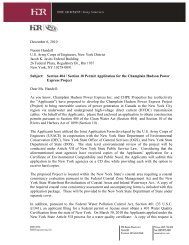Champlain Hudson Power Express Brochure
Champlain Hudson Power Express Brochure
Champlain Hudson Power Express Brochure
Create successful ePaper yourself
Turn your PDF publications into a flip-book with our unique Google optimized e-Paper software.
The<strong>Champlain</strong><strong>Hudson</strong><strong>Power</strong><strong>Express</strong>Project
The <strong>Champlain</strong> <strong>Hudson</strong> <strong>Power</strong> <strong>Express</strong>(CHPE) ProjectThe <strong>Champlain</strong> <strong>Hudson</strong> <strong>Power</strong> <strong>Express</strong> Project is a 333-mile, buried transmission linethat will bring up to 1,000 megawatts (MW) of clean, renewable energy to the New YorkCity metropolitan area. 1,000 MW is enough power to serve approximately one millionresidential customers.The $2.2 billion project, financed completely by the private sector, will deliver renewablepower to meet New York’s growing demands, increase the security of the state’selectric grid, reduce greenhouse gas and other air emissions and lower energy costs forconsumers.The project will also diversify the state’s energy portfolio and increase the electric grid’ssafety and security by creating new, hardened infrastructure that is less susceptible todamage from natural disasters. In fact, New York City supports this project as part of itsoverall effort to prepare the city for climate change.Five-inch diameter HVDCcable cross-section usedin this project.Scan the QR code above withyour smartphone and watchthe installation video.Safe, Buried TransmissionThe CHPE Project will consist of two buried High Voltage Direct Current (HVDC) cables,each five inches in diameter. This technology is extremely controllable, which allows thesystem to integrate more intermittent renewable resources onto the grid. It will alsoprovide additional benefits including black-start capability for quick restoration of thestatewide electric system in the event of a blackout and voltage control for managementof daily load swings. All of these benefits put the project at the forefront of America’semerging “smart grid” revolution. The cables are solid state, nonflammable, andwell insulated.The cables will be buried mostly in public and railroad rights of way and avoid the visualimpacts of overhead transmission projects. The cables are virtually maintenance freeonce installed and have been in use all over the world for more than 60 years.installationWhen in water, the cables will be buried an average of six feet deep, using low-impactwater-jet technology over much of the route.When on land, the cables will be buried up to five feet deep. The trenches needed tosafely bury the cables will be minimally invasive, averaging only four feet wideduring installation.1 | Transmission Developers Inc. www.CHP<strong>Express</strong>.com | 2
1Raquette R.PlattsburghL. <strong>Champlain</strong>The RouteThe project extends 333miles, traveling from theU.S.-Canadian border to NewYork City. The cables will beburied mostly on public andrailroad rights of way.Niagara FallsTonawandaNew York State’s <strong>Power</strong> NeedsThe New York energy market is comprisedof approximately 42,000 MW of energysupply resources which need to becontinuously expanded and modernized tomeet the steady growth of the New Yorkmarket’s electricity demand. With an agingenergy infrastructure, New York State willBuffaloCheektowagaWest SenecaNew York City’s <strong>Power</strong> NeedsWhile residents and businesses inside andoutside of New York City will see lowerpower prices and new jobs as a resultof the CHPE Project, this new source ofclean, renewable power will play a majorrole in helping New York City meet itsaggressive clean energy goals. MayorBloomberg has announced plans toRochesterneed many solutions to address its energyfuture. An analysis done as part of NewYork’s Energy Highway initiative found thatmost of the state’s transmission lines aremore than 50 years old and many need tobe replaced in the next 10 years.Finger Lakesreduce New York City carbon emissions by30 percent by 2030, and the CHPE Projectwill play a role in accomplishing that.The clean power being delivered by theCHPE Project is a major reason whycitizen groups fighting for cleaner air inthe New York City borough of Queens aresupporting the project.Oneida L.BinghamtonSyracuseUticaGreat Sacandaga L.Mohawk R.SchenectadyAlbany45L. George63HUDSON RIVER2New York CityThe route begins at theU.S.-Canadian border 1 andtravels most of the distanceof Lake <strong>Champlain</strong>, emergingfrom the water at the south endof the lake 2 . From there theCHPE Project continues alongstate highway and railroadrights of way, then enters the<strong>Hudson</strong> River in Catskill 3 .The route then stays in the<strong>Hudson</strong> until it reachesRockland County 4 , whereit travels on land for ninemiles before re-entering the<strong>Hudson</strong> River. Once back in the<strong>Hudson</strong>, the route continuesdown to the junction of the<strong>Hudson</strong> and Harlem Rivers,follows the Harlem down tothe vicinity of the new WillisAvenue Bridge 5 , and finishesits journey with short stretchesburied on land in the Bronxand Queens. Finally, it reachesits destination along the EastRiver—a new converter stationthat will be built in AstoriaQueens 6 .3 | Transmission Developers Inc. www.CHP<strong>Express</strong>.com | 4






